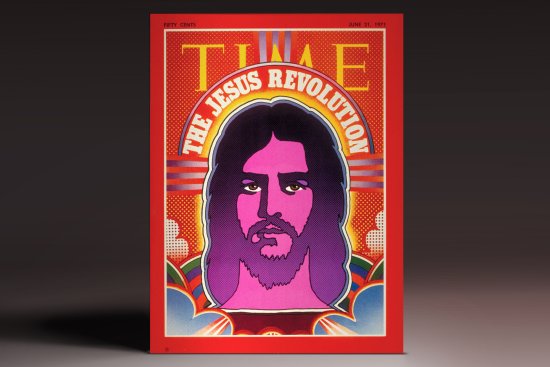
The surge in young people adopting the Christian faith in the '70s was recently dramatized in a movie with the same title.
Buy a print of the Jesus Revolution cover here
“We didn’t call it a revolution,” says Pastor Greg Laurie, of the sudden surge in young people adopting the Christian faith in the ’70s, first in California, then across the U.S. and around the world. “TIME magazine coined that phrase. We called it ‘The Jesus Movement.’ But I think actually TIME editors had it right, because they saw something bigger.”
In April 1966, TIME had published one of its most controversial covers ever, posing a simple question in white type on a black background: “Is God Dead?” The issue, which delved into a theological hypothesis of the era, was greeted with enraged sermons and more than 3,000 letters to the editor. (“Your ugly cover is a blasphemous outrage,” read one.)
Yet just five years and two month later, God’s son was the cover star, looking like the lead guitarist in a folk-funk band proclaiming that reports of a divine death were premature. “Jesus is alive and well and living in the radical spiritual fervor of a growing number of young Americans who have proclaimed an extraordinary religious revolution in his name,” wrote Mayo Mohs, who was responsible for the magazine’s religion section at the time. “There is an uncommon morning freshness to this movement, a buoyant atmosphere of hope and love along with the usual rebel zeal.”
[time-brightcove not-tgx=”true”]More from TIME
Read the full story here in the TIME Vault: The Jesus Revolution
The cover art, which is by Stanislaw Zagorski and now in the collection of the National Portrait Gallery, is among TIME’s grooviest. But Laurie, who had no role in the story and knew nothing of it until he saw the issue, remembers it feeling exactly right. “It felt very current to us,” he says. “Kind of this psychedelic Jesus that wasn’t just traditional Christianity. We were having this fresh encounter with God.”
Laurie, now a senior pastor at Harvest Christian Fellowship in Riverside, Calif., was at the time one of those fresh-faced rebels. His is a tale as old as tax collection: a hotheaded youngster from a difficult background who was heading down a treacherous path until he had a literal come-to-Jesus moment and became a believer, and eventually a pastor. His story and the role of the two TIME covers were recently dramatized in a movie, also called Jesus Revolution.
Jon Erwin, the director, met with Laurie in the spring of 2016 and brought a copy of the magazine with him. “He said, ‘You know, I want this to happen for my generation. And I want to make a movie about this,’” says Laurie. Several months later, Erwin sent Laurie a script in which a character based on the pastor played a major role. The movie was released in February and surprised industry watchers by taking in more than $50 million in theaters.
The TIME story talks of baptisms taking place “at a cul-de-sac beach at Corona del Mar, California,” at a place known as Pirates Cove Beach. “Under a setting sun, several hundred converts waded into the cold Pacific, patiently waiting their turn for the rite. On the cliffs above, hundreds more watched. Most of the baptized were young, tanned and casual in cut-off blue jeans, pullovers and even an occasional bikini.” Laurie was baptized there in 1970. On July 8, he will be doing the dunking, as people inspired by the movie gather together to reprise the baptisms, and maybe—in an era when faith is on the decline, Christians are divided, and young people are reporting higher levels of anxiety and depression—kick off another spiritual revival.
Until the TIME cover, Laurie says he and his friends weren’t aware of how far the movement had spread. Three things cemented it in many people’s minds as a bona fide phenomenon: mega-evangelist Billy Graham gave it a shout-out, there was a gathering in Dallas that drew 80,000 young people, and TIME put it on the cover. “I think the writer of the article had an understanding that some of us didn’t even have at that moment,” says Laurie. “When we saw that cover, it sort of officially told us, Wow this is a lot bigger than we thought.”
To mark TIME’s 100th anniversary, we’re revisiting some of our most influential covers, with the people who lived that history. Find more of this series at time.com/100-years